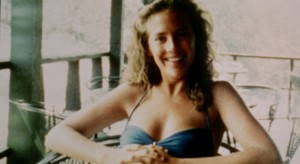Have you ever looked into someone’s eyes, and for a moment, the rest of the world around you fades into nothingness? For that one moment, you feel entrap ped by an unexplainable feeling. This short but deep infatuation is what so many strive to share with one they can call their own. Many don’t know what love is until they see it. And when they see it, they know.
ped by an unexplainable feeling. This short but deep infatuation is what so many strive to share with one they can call their own. Many don’t know what love is until they see it. And when they see it, they know.
Throughout Sherman’s March, or should I say, Ross’ March, we see a man who has had a chance at everlasting love, but lost it. His passion of film-making becomes taken hostage by his pursuit for love, and his original intention for the documentary vanishes. During the film, it seems that only the love from another women can complete him.
Sherman’s March: A Meditation on the Possibility of Romantic Love In the South During an Era of Nuclear Weapons Proliferation is not the movie title I agreed to watch. In fact, I found the full-length title after viewing the film. Ross uses the interesting tool of deception in order to not only fool his audience, but set them up for an unexpected journey. The shift in content shows how just a human emotion can severely change a person’s life, as well as the way they think, act, and feel.
The film is constantly conveying Mcelwee’s thoughts and feelings of love and lust while the camera is shot from the perspective of Ross. I believe he does this to share his perspective with the viewers, in the hopes that they can feel what it’s like to lose something so important to them. While most of the film is shot in the first-person point of view, moments of Ross’ self-reflecition are given randomly throughout his journey. During these scenes, the audience is given a one-on-one session with the filmmaker. In these scenes, he reflects on specific experiences he deals with while on his journey. When he is not speaking directly to the audience, he is either speaking to strangers, friends, or family, o
r to himself. As he speaks directly to the audience, he gives the viewers a taste of Mcelwee’s truest emotions and thoughts. This is done in many works of non-fiction.
Seeing my first CNF documentary opened my eyes to the number of techniques that filmmakers, as well as authors, can portray different emotions throughout the piece. Ross has different ways of shooting to help him show the audience his truest emotions. In many scenes, we see Mcelwee filming one of the many females that he desires. While only she is being filmed, Ross rants about the girl and how he feels about her. This is a way that the filmmaker uses narration as well as his camera to instill emotion in the viewer. You can find some similar techniques in works of literary CNF. In her short stories, Joan Didion uses similar literary techniques in order to establish a relationship with her audience. Similar to scenes in Sherman’s March: A Meditation on the Possibility of Romantic Love In the South During an Era of Nuclear Weapons Proliferation, Didion focuses on a specific character and holds nothing back when describing them. She creates a scene in the reader of a specific setting in history, and as she does this, she inputs her own feelings. CNF writers do this so well, that at times, the audience is completely unaware of the influence of the author on the events and experiences they go through.